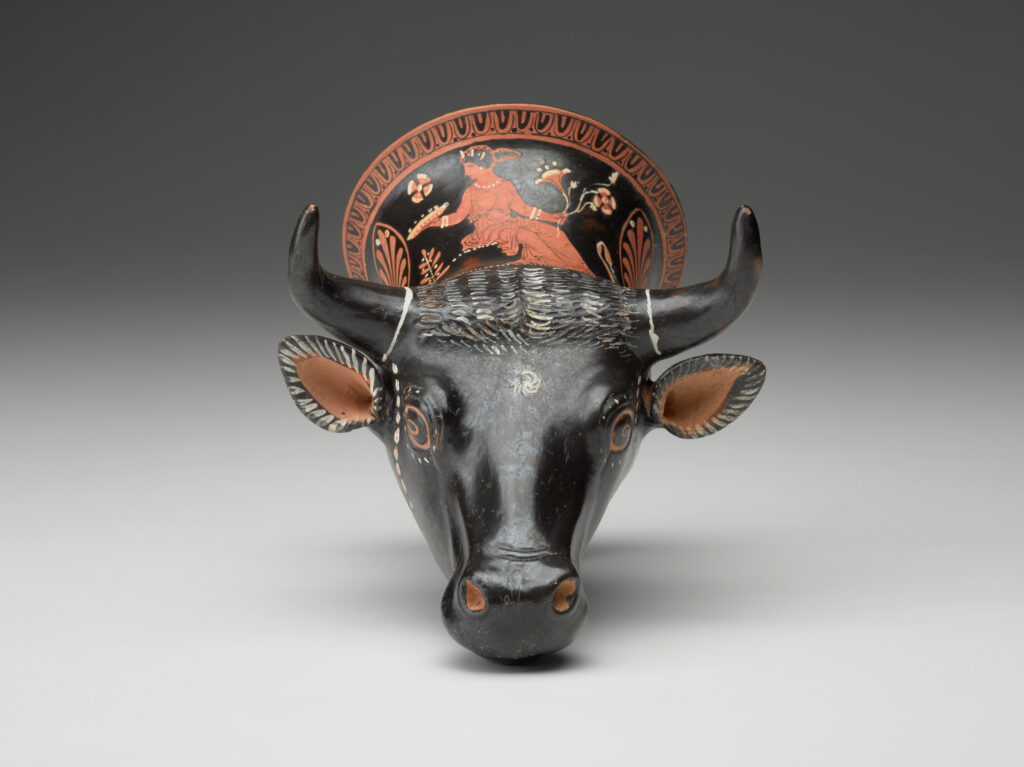Bull’s Head Rhyton (work of art)
Artwork Info
About
Key Ideas
- This shape of vessel is known as a rhyton. Rhyta (plural of rhyton) are used to pour liquids. They have two openings. When both holes are unstopped, liquid flows out of the smaller opening at the bottom.
- The name rhyton comes from the ancient Greek word rhysis, which means “flow.”
- This rhyton was made in the workshop of the Darius Painter, who was well known in southern Italy during the fourth century BCE. The real name of the Darius Painter is unknown. The artist was given this name because of a large vase they created; the designs on the vase depict the ancient Persian king Darius.
- This rhyton was decorated using the red-figure technique. Red-figure vases have black backgrounds with decorative scenes and figures that are painted red. This pottery painting technique was invented around 530 BCE.
Learn More
Animal-shaped drinking vessels have been made since the late Neolithic period. They have been found in cultures across Asia, Europe, Africa, and the Americas. The bull was one of the more commonly used forms in animal-shaped vessels in the Aegean region. Bulls symbolized strength, and they were valued for their role in agriculture and for their meat. Bulls were also common in animal sacrifices to deities (gods and goddesses).
The form of the rhyton was most likely inspired by the ancient practice of using animal horns as drinking vessels or for libations. A libation is a liquid offering poured for a deity. A rhyton would have been used for ceremonial purposes like pouring a libation. Rhyta were also used at social gatherings such as the symposium.
The symposium was a gathering for upper-class males in Greek society. Participants would have talked, listened to music, and even recited poetry. There were specific vessels associated with the symposium. These would have included rhyta, mixing vessels, cups, coolers, and jugs. Objects used in the symposium were often decorated with scenes of parties or images of Dionysus and his followers. Dionysus was the Greek god of wine and theater.
This rhyton was decorated using the red-figure pottery painting technique. This technique, invented in the sixth century BCE, gradually replaced the earlier black-figure technique. These two techniques are visual opposites. Black-figure vases have a red background, and red-figure vases have a black background. To make a red-figure vase, the pottery maker or painter would have first covered the vase’s surface with slip. Then they would have added details with small lines of glaze. The slip-covered areas of the vase turned black when fired in a kiln, and the uncovered areas turned red. To make a black-figure vase, the painter would have added decorative scenes using slip and then carved the details into the vase (instead of painting them on with a brush). Both red-figure and black-figure pottery pieces were fired using a three-step process. In the first step, air was let into the kiln, and the whole vase turned the color of the clay. In the next step, the oxygen in the kiln was reduced and the vase turned black in the smoke-filled kiln. In the final step, more oxygen was added to the kiln. The areas of the vase that were covered with slip remained black, and the uncovered areas turned red.
This rhyton is attributed to the Darius Painter. This vase painter was well known in Apulia (a region in the southeast of Italy) in the fourth century BCE. The Darius Painter’s workshop may have been located in the city of Taranto, which the Greeks called Taras. The city was founded as a Greek colony in 706 BCE by immigrants from Sparta. The coastal regions of southern Italy were home to many Greek settlers. Ceramics imported from Athens have been found throughout Apulia. Ceramic artisans in Apulia first used techniques and styles from Athens. It is possible that the earliest red-figure Apulian painters were Athenians who had moved there. Apulian-produced vases were typically made for a local market. They were often decorated with intricate mythological scenes.
Additional Resources
Resources for Teachers:
- View a similar example of a rhyton.
- Read an article about Greek vase painting.
- Watch a video featuring the recreation of a red-figure vase.
- View a teaching resource on Greek colonization.
Resources for Students:
- Watch a video about Greek vases.
- Watch a video about rhyta.
- View a similar example of a rhyton.
- Watch an animated video about the invention of red-figure painting.





